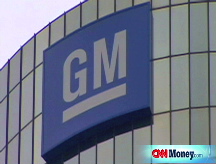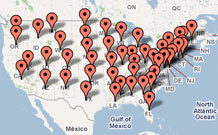What's on the line for the UAW
Some of the goals of the Bush auto bailout plan deal with real issues - but some don't quite hit the mark.
 |
| Contrary to what many people think, union auto workers' hourly pay and work rules aren't that different from those of non-union workers. |
NEW YORK (CNNMoney.com) -- President Bush's bailout plan contains some "targets" the government wants the automakers and the United Auto Workers union to achieve before agreeing to a bailout loan.
All of the terms are still negotiable as long the automakers can produce a plan to become viable without them.
The terms, as laid out by the White House, appear simple on the surface, but the issues they cover are a lot more complicated. Here's a rundown:
The way it is now: Domestic automakers' labor costs are considerably higher than those of foreign competitors operating here in the United States.
What's in the bailout: By 2010, domestic automakers must pay hourly wages that are on par with those offered by their foreign competitors.
Reality check: Hourly wages for comparable work at General Motors (GM, Fortune 500) and Toyota are nearly identical. According to various reports, each company pays experienced auto workers about $30 an hour.
It's when benefits are factored in that cost differences begin to rise, opening up differences of several dollars per hour.
But the real issue for U.S. automakers - the factor that gives rise to stories of autoworkers bringing home more than $70 an hour - is retiree benefits. Those hourly figures, which were calculated by the automakers before the latest round of contract negotiations in 2007, include money paid into retiree healthcare and pension funds - not just the pay and benefits of active workers.
Those retiree costs are the reason that the UAW created trusts to cover them so that automakers wouldn't have to continue paying for retiree benefits out of their own funds indefinitely.
The way it is now: Various work rules built into union contracts cover things like paid holidays and dictate specific job descriptions laying out exactly what each worker can and cannot be required to do as part of his job.
What's in the bailout: Domestic automakers' work rules must be competitive with those at foreign auto plants in the United States, like those run by Toyota, Honda and Nissan.
Reality check: It's commonly thought that the domestic automakers' plants are far less efficient than plants run by foreign automakers. The blame usually goes to strict work rules that rigidly define each union worker's job function.
Here's an extreme, but common, perception: If an assembly worker sees a piece of trash on the floor, he can't just bend over and pick it up because that would infringe on another worker's job.
"That was true 10, 20, 30 years ago," said Ron Harbour, an auto manufacturing consultant and analyst. Those sorts of efficiency-strangling rules have been negotiated out of contracts over the years.
The rules that do remain mostly involve legitimate safety concerns, he said, and don't hurt efficiency. For example, fixing an electrical problem still requires a union electrician. "If you are not a trained electrician, you can kill yourself," he said. "That makes sense."
His annual Harbour Report ranks auto factories by their efficiency, or the number of worker-hours required to produce a car. In his most recent report, he found nine of the 10 most efficient auto plants in North America are unionized plants run by domestic automakers. The 10th is a unionized auto plant run jointly by GM and Toyota.
The way it is now: Under labor agreements, laid-off union workers are furloughed while receiving almost their entire pay.
What's in the bailout: The plan calls on automakers and unions to eliminate these so-called jobs banks.
Reality check: After the automakers went to Congress asking for bailout loans, the UAW offered to eliminate the jobs bank. That wouldn't eliminate something called supplemental pay, though. Workers go into sub-pay, as it's called, immediately after being laid off and go into the jobs bank only after their unemployment benefits run out.
While on unemployment, state benefits are supplemented by money from the automaker. In the case of General Motors, the total compensation adds up to 72% of a worker's original pay, according to a GM spokesman.
After that, the employee goes into the jobs bank and receives either 85% of his pay or 100% if he's asked to come in for training or other work.
If a job becomes available at any time within 50 miles of a GM worker's old job, he or she must accept it. If jobs become available elsewhere, the worker is allowed to turn down up to two more distant reassignment offers.
Years ago, the jobs banks were much more expensive for automakers than they are today, according to a General Motors spokesman, because many workers have left the company through employee buyout programs and early retirement. Recent rounds of plant closings and layoffs are expected to push these costs back up, though.
What Toyota does for its workers is actually very similar to the jobs bank, but without the sub-pay period. Toyota has a strong "no layoff" policy, so workers stay on the company payroll at full wages while they are assigned to either training programs or other jobs within the company.
Up to a point, jobs banks do offer some benefit to the automakers themselves. Automobile sales are highly cyclical and even in good times, workers sometimes have to be idled for weeks as factories are retooled or inventory is sold off.
Without some way to support themselves during that time, workers may look for other jobs, requiring automakers to go through a massive hiring and training process for new workers when the lines start back up.
The way it is now: In last year's round of contract negotiations, domestic automakers agreed to put money into a union-controlled investment fund that would pay for future retiree benefits. It was called the Voluntary Employees' Beneficiary Association (VEBA). The biggest benefit for automakers was that it removed these costs from their books.
What's in the bailout: Half of VEBA payments must be paid in company stock.
Reality check: Under the original VEBA rules, automakers are already allowed to make some payments in company stock. With GM stock at extremely depressed levels already, this might not be a bad move.
If GM can become a financially viable company again, its stock price is bound to go up, adding more value to the fund.
How much auto workers will have to concede ultimately depend on how much money is available for the final bailout loans, said Brad Coulter, a director with O'Keefe and Assoc., a Detroit-based bankruptcy and turnaround consulting firm.
Coulter expects the automakers to borrow even more money later beyond the $17.4 billion on the table to keep the automakers alive while they plan their restructurings, but the question is just how much. "As they run their numbers, what kind of cash burn is the lender willing to fund?" he asked.
If there isn't enough money available to continue programs like 48 weeks of sub-pay for workers, the UAW may be forced to accept major cuts or watch the Chrysler and GM file for bankruptcy.
The UAW will want to hold off on offering any concessions until the more labor-friendly Obama administration comes to office, according to John Rivette, a professor of labor relations at Michigan State University.
"Behind the scenes, they're going to pressure the Obama administration and congressional Democrats," he said.
The changes being asked of workers represent relatively small dollar amounts in light of the larger problems facing the automakers. "The much bigger thing," he said, "is what can be done with the suppliers and the dealers." ![]()



